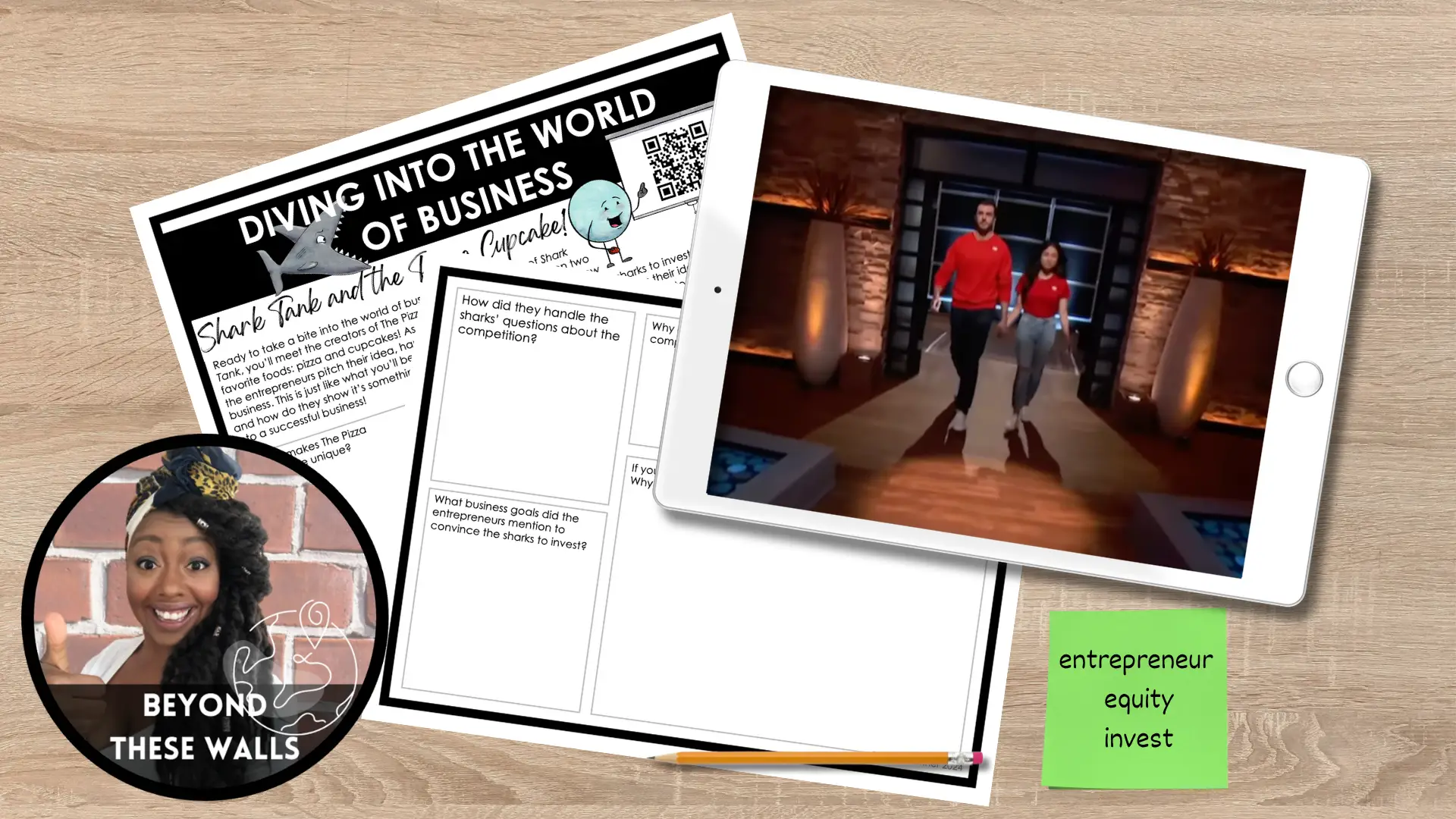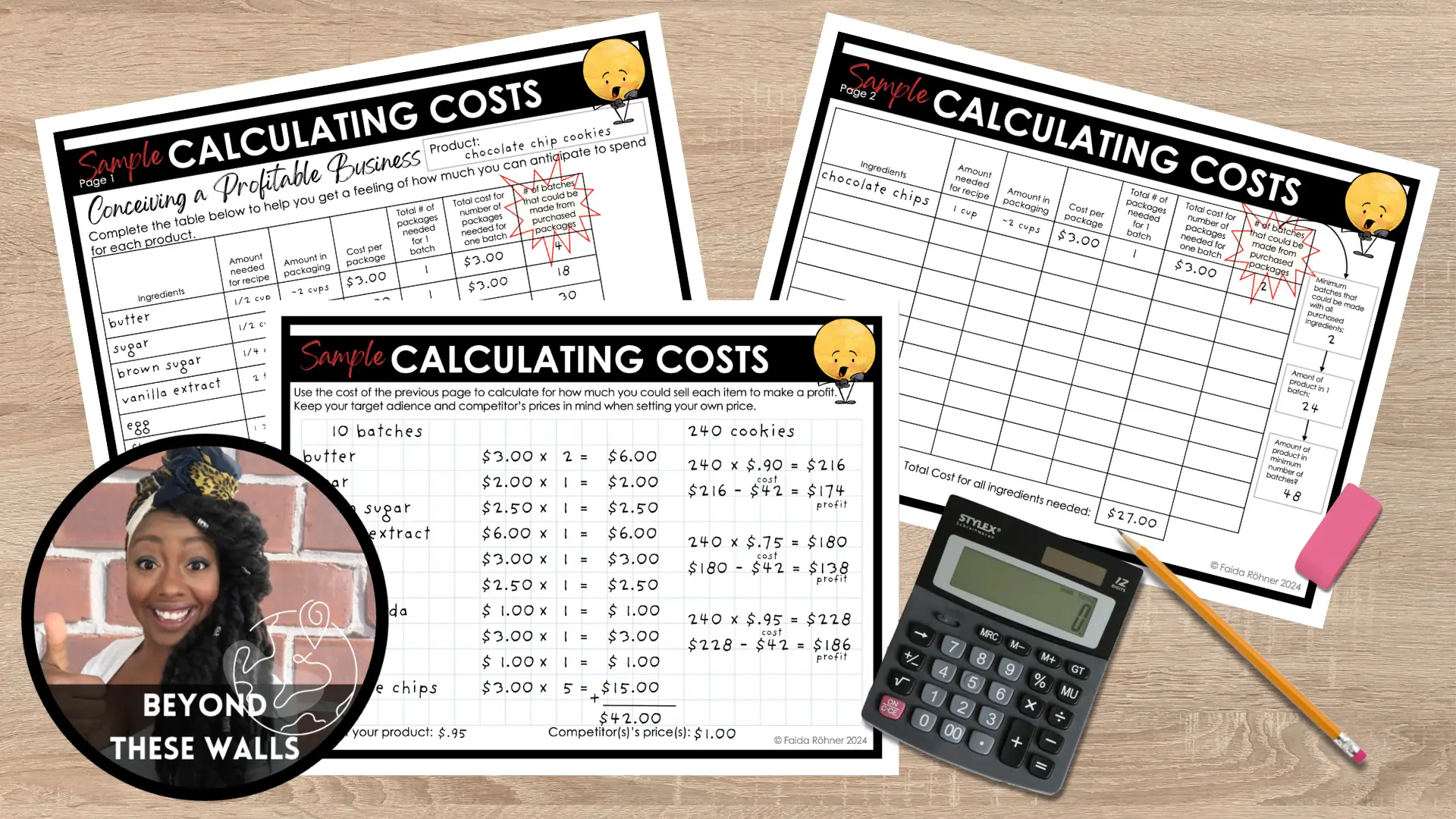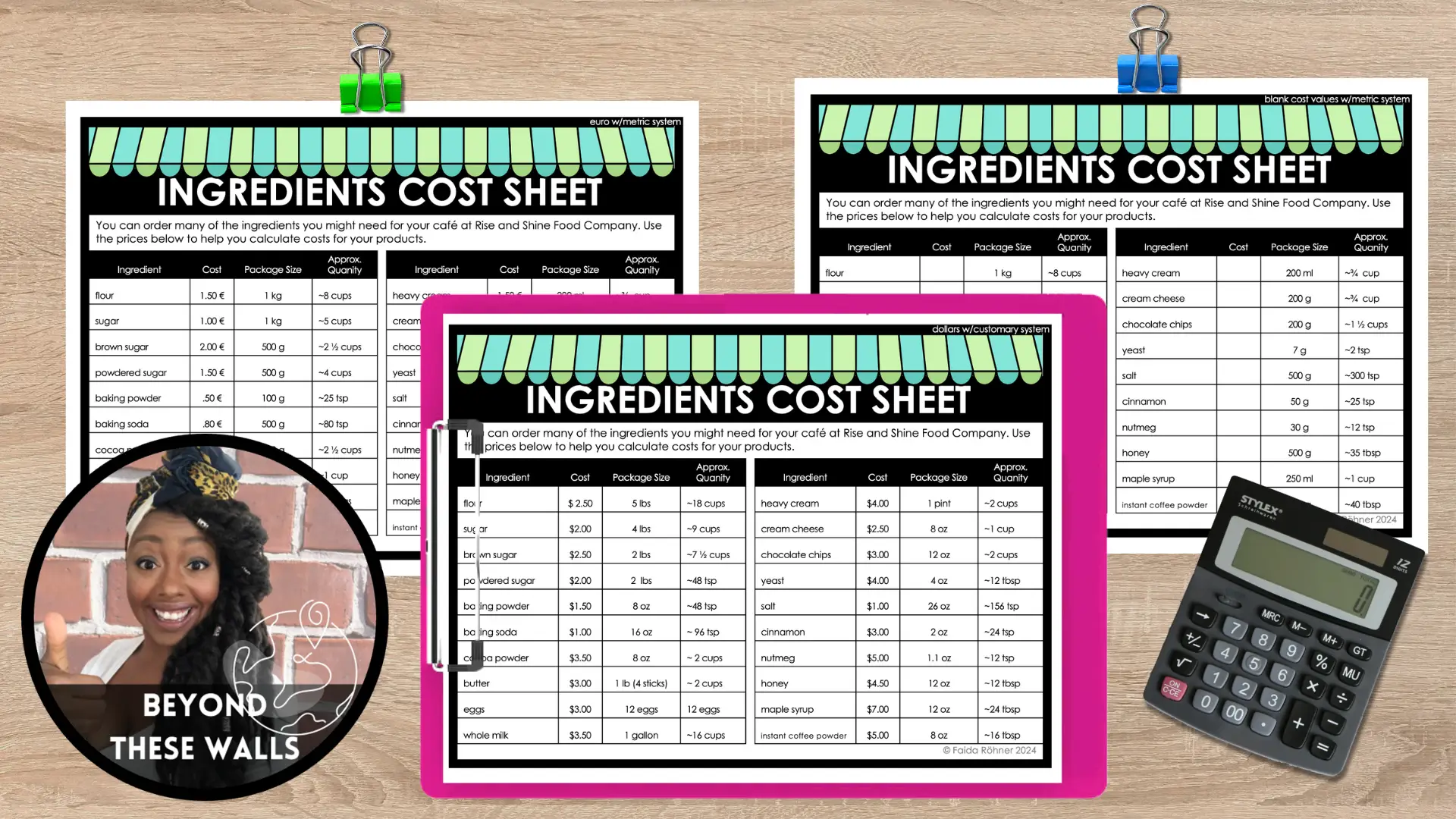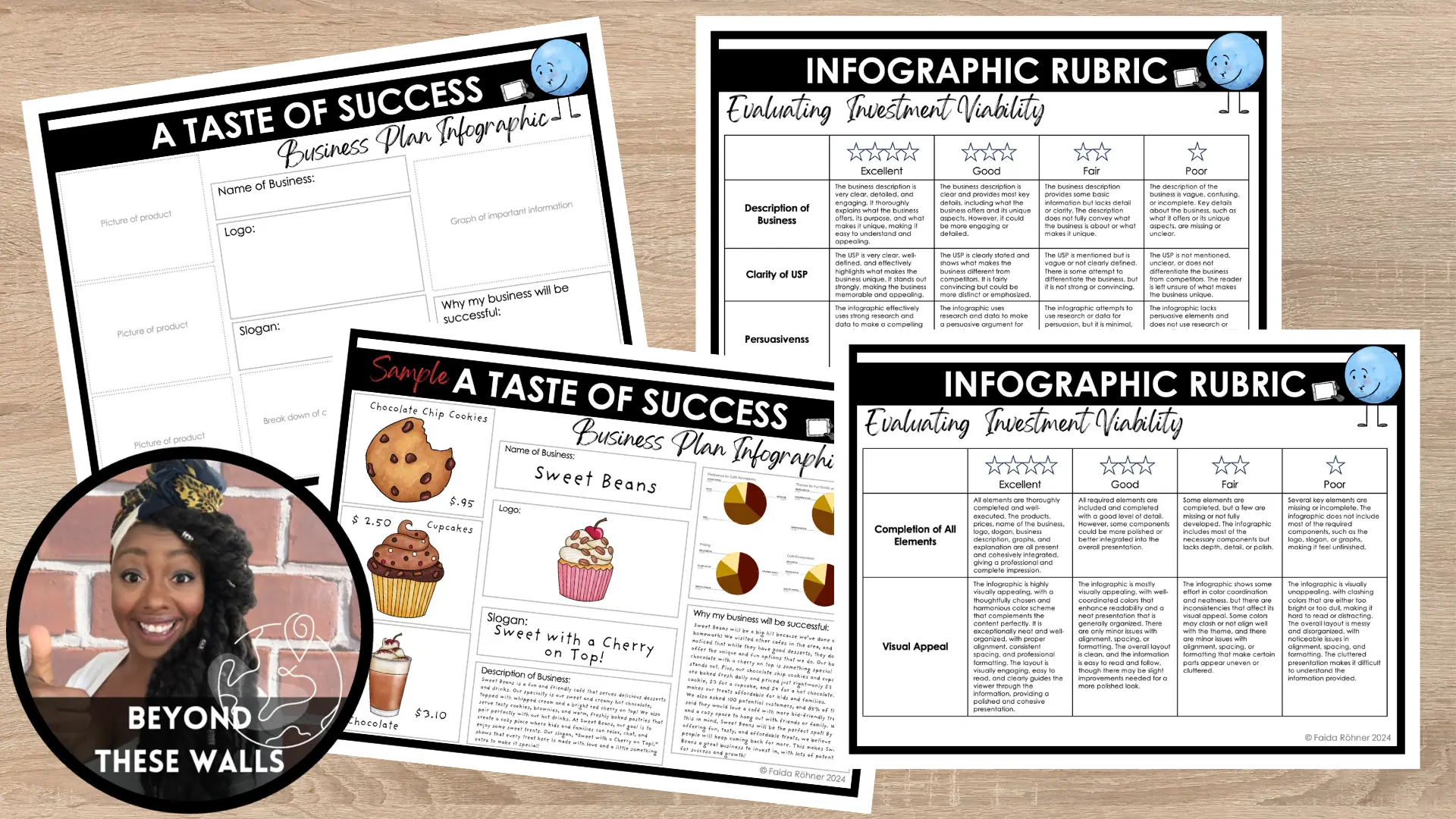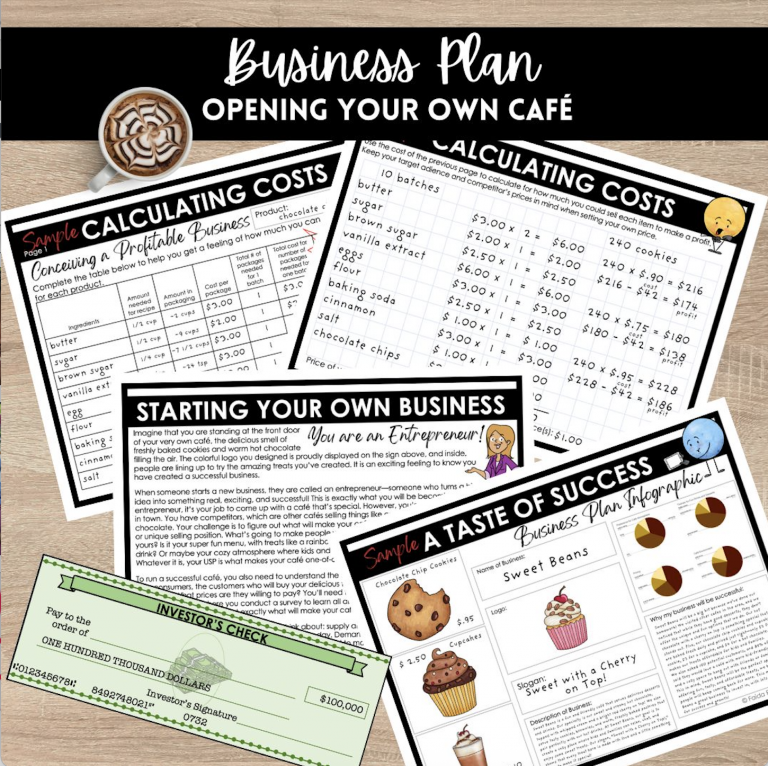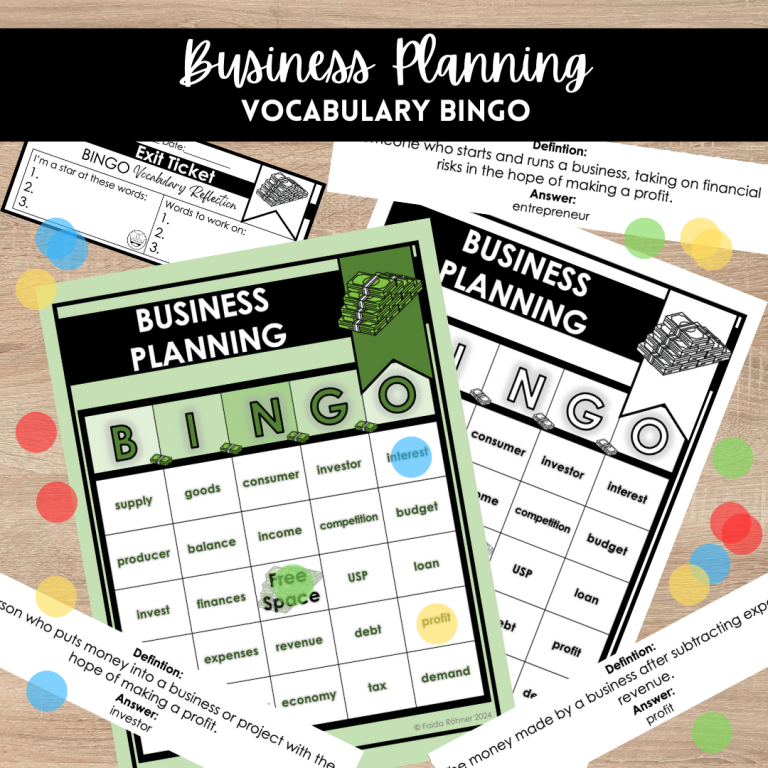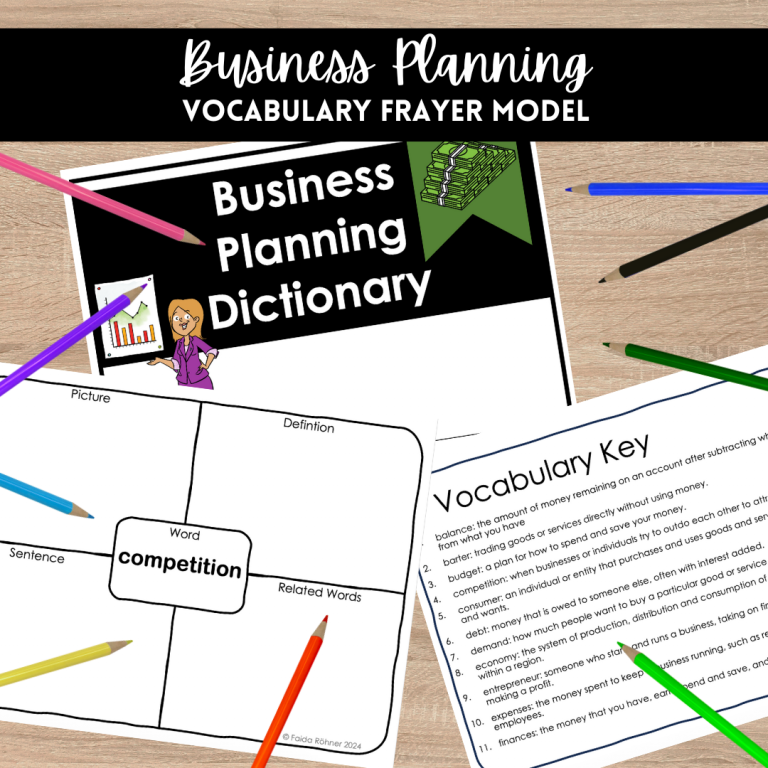The Dizziness of Teaching Business
Let’s be honest—teaching business to kids sounds intimidating. Like, am I suddenly supposed to have gotten an MBA alongside my teaching degree and be prepared to give a lesson on quarterly earnings. This was the anxiety I faced the first time I had to teach a business unit to 5th graders. I felt completely out of my depth. I wanted to make the learning meaningful and authentic, but I didn’t know where to start.
After the dizziness of everything that I would possibly need to teach—and let’s be honest…learn—I decided to start by looking at what the 5th grade teachers had done in the past. Students had made and sold their own products, which I liked, but I wanted to go beyond that. My goal was for the experience to reflect what it’s really like to go through the process of opening a business. Instead of simply having students create something and then reflect on how well it sold, I wanted them to dig deeper. That meant thinking critically before they made anything. Questions that needed to be answered were…
- What makes a business idea strong?
- How do you know if people will actually buy what you’re selling?
- What makes one product stand out over another?
- What skills do entrepreneurs need to make a business successful?
How I Developed my own Unit on Business for Kids
At the time, I was dating my now-husband, who happened to be working as a business consultant for startups. He shared a real business proposal template with me—one they used with new clients. It was in German, so I had to do some serious work to translate the terminology and make it kid-friendly. But as I looked through it, something clicked.

This wasn’t just about making a product. It was about:
- Finding an idea that excited you—and your potential customers
- Understanding your competition and what makes your business different
- Sticking to a budget and realizing that starting a business is expensive
- Convincing investors that your idea is worth backing
- Doing real market research to make data-informed decisions
- Learning how to sell—through logos, slogans, and a pitch that sticks
I adapted the real-world plan to work for my students, consulted with our secondary business teacher, and revised until I had a student-friendly version that aligned with what they’d see in later grades. It was a LOT of work, but watching students go through the process like real entrepreneurs? Worth every second.
If you’re feeling like I was—completely overwhelmed—or if you’re just looking to enhance an economics unit you’re already doing, I hope this post gives you both inspiration and practical tools. I’m breaking it all down, step-by-step, so you can jump in wherever it makes sense for you and your students.
Teaching Business to Kids Table of Contents
In this blog post, I’ll walk you through my entire unit for teaching business to Kids. You can click the sections below to go directly to any section.
- Backwards Planning: Start with the End in Mind (Because Winging It Isn’t a Strategy)
- Provocation: How to hook your students and get them excited
- Involving students in planning: Not My Unit—Our Unit…Letting Students Lead the Way
- Brainstorming & Business Besties: Teamwork that works
- Bringing in the Big Guns: Learning from a Real Business Consultant
- Know Your Rivals: Competitor Analysis Made Kid-Friendly
- Survey the People: Market Research That Actually Matters
- Build the Brand: Logos, Slogans, and the Art of Standing Out
- Calculating Costs: Budgeting like a boss
- Pitch Perfect: Infographic Business Plan That Sells
- Pitching to Investors: Student Shark Tank
- Bake It Till You Make It: Selling Day Success (Bonus Step)
- Helping You Teach Business for Kids: From Real Ideas to Real Learning
I’ve also created an Ultimate Business Plan Bundle, available on TpT, that includes all the tools I used with my students—handouts, business planning sheets, an infographic template and rubric, and more. You absolutely don’t need it to try this with your students, but if you’re short on time (or want a head start), it’s there to make your life easier.
Ready to dive in?
Backwards Planning: Start with the End in Mind (Because Winging It Isn’t a Strategy)
Before diving into activities, discussions, or even vocabulary, I had to figure out one big thing:
What exactly do I want my students to do by the end of this unit?
This is where backward planning saved me.
Instead of just coming up with a series of lessons and hoping they’d magically tie together, I started with an authentic assessment—a real-world task that would drive the learning forward. I wanted the unit to feel meaningful and connected to skills my students would actually use someday. So, I turned to one of my favorite tools for crafting authentic tasks: the GRASPS model.
If you’re new to GRASPS, you can read more about it in my post Taking GRASPS of Real World Learning. It’s my go-to framework for building performance tasks that mimic real-life challenges.
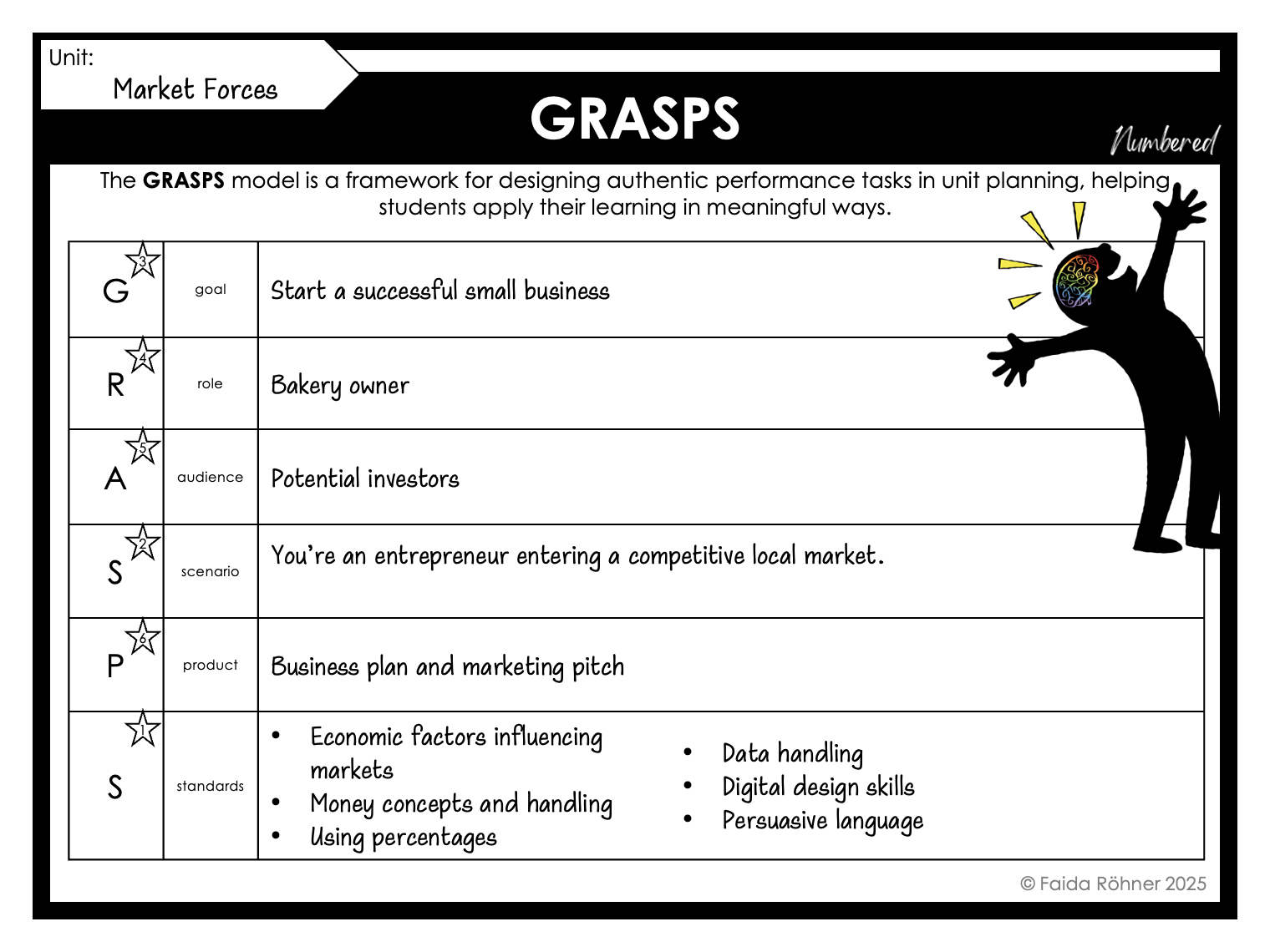
Using GRASPS to Design an Authentic Business Unit for Kids
Here’s what my scenario looked like in action:
Your goal is to start a small business—and make it successful.
You’re taking on the role of a bakery owner, ready to launch a brand-new product into a competitive local market. But first, you’ll need to convince potential investors that your idea is worth backing. To do that, you’ll create a business plan and a marketing pitch that clearly explains your product, how you’ll sell it, and why your business will stand out. Along the way, you’ll need to understand what influences markets, how to manage money wisely, work with percentages and data, use digital tools to create your branding, and convince your audience using persuasive language.
Pretty real-world, right?
This one scenario became the anchor for everything we did. Every mini-lesson, every activity, and every reflection tied back to helping students succeed at this final task.
The beauty of using a GRASPS task is that it gives your unit structure and purpose. Students know from the beginning what they’re working toward, and it makes every step along the way feel important—because it is.
If you’re building your own business unit, I highly recommend starting here. Think about what you want students to walk away with. What can they create or present that mirrors what real entrepreneurs do? When that vision is clear, planning the rest of your unit becomes so much easier.
Provocation: Using Shark Tank as a Hook
To kick things off, I wanted my students hooked—and nothing says “real-world business drama” quite like an episode of Shark Tank.
I queued up a short, kid-friendly clip from the show (you can find a lot of great ones online) and had my students watch with a specific purpose:
What do entrepreneurs do to convince investors that their product is worth the risk?
It was the perfect provocation—a high-energy, real-world example that instantly got students thinking, wondering, and asking questions. They were fascinated.
After the clip, we unpacked it together. We discussed some business vocabulary like:
- entrepreneur
- investor
- product
- pitch
- equity
- profit
- target market
- USP
Helpful Note: These key words were an introduction to business concepts that we developed throughout the entire unit. Learning terminology is key for helping students give language to their learning. I used the Frayer Model to help students develop vocabulary and we played BINGO to help students review these words in a fun way. This was particularly helpful for my English language learners.
After watching the Shark Tank video, we also explored some deeper questions:
- What strategies did the entrepreneurs use to persuade the sharks?
- Why would an investor even want to give someone money? What’s in it for them?
- What kinds of information do you need to have before you start a business?
Then came my favorite part…student questions:
They wrote down what they didn’t understand yet, what surprised them, and what they wanted to learn more about. These questions became the launchpad for our inquiry and drove a lot of our learning in the weeks that followed.
If you’re new to using provocations in your units, they’re a fantastic way to ignite curiosity and encourage student-driven learning. You can read more about how I use provocations in my blog post, The Power of Provocations: Starting Units and Sparking Curiosity.
Involving Students in Planning: Not “My” Unit—”Our” Unit…Letting Students Lead the Way
After the Shark Tank excitement had simmered down (just a little), it was time to make this learning journey truly theirs. I didn’t want a unit where I stood at the front and handed out instructions like some kind of corporate boss. I wanted my students to feel like real entrepreneurs—curious, creative, and in control.
We started by diving into an article about what entrepreneurs actually do. It was important for them to understand that being an entrepreneur isn’t just about having a fun idea. It’s about taking risks, solving problems, and working really hard to bring something new into the world.
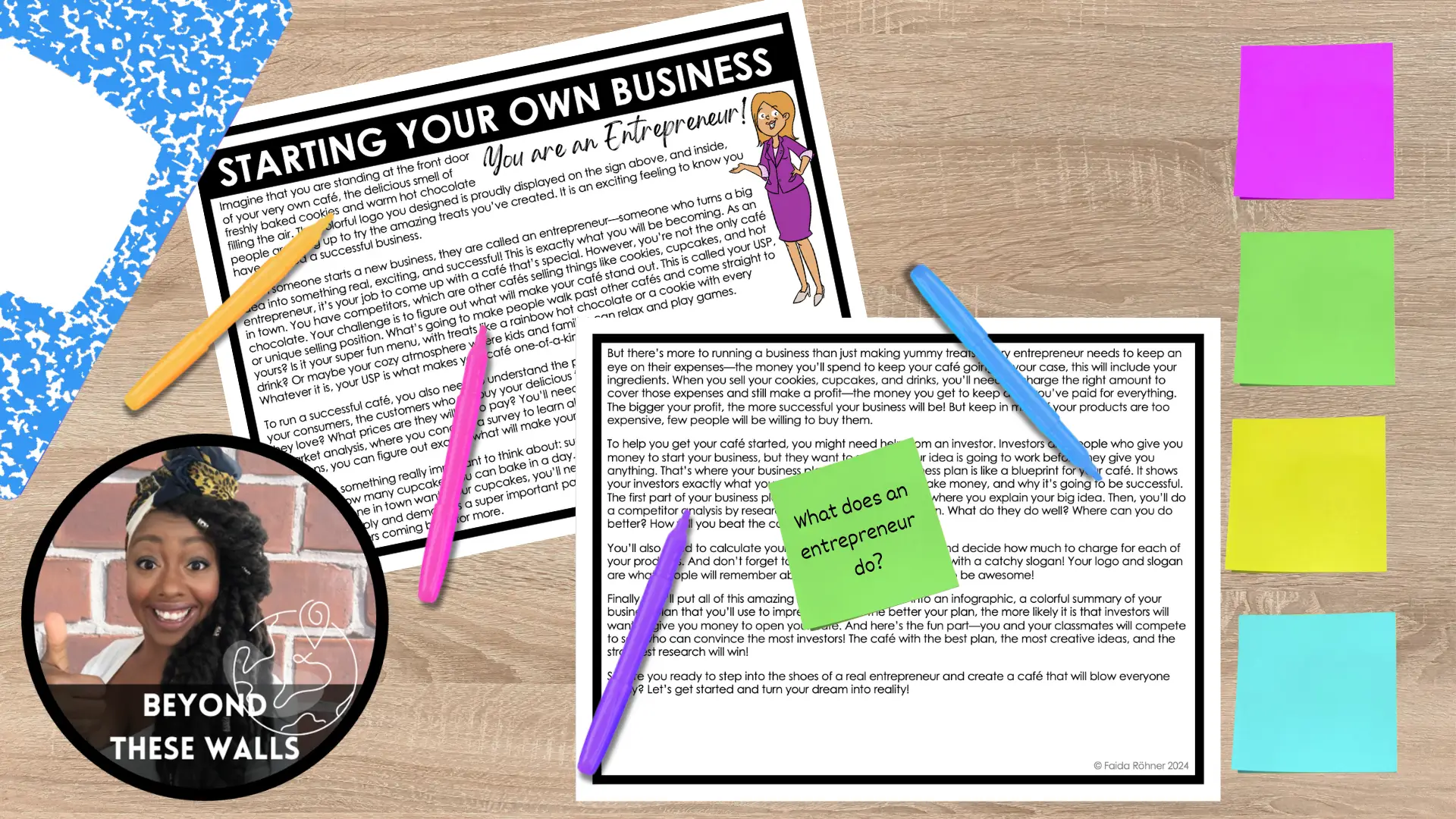
Then I posed the big question:
If you were going to start your own business, what would you need to know to make it successful?
To guide their thinking, I handed them a simplified version of a real business plan—the same one I created after adapting a professional plan my (now) husband used as a consultant. Students explored it and jotted down all the skills and knowledge areas they thought they’d need to complete it well.
I was honestly blown away by their insights. Some of the skills they brainstormed hadn’t even made it onto my list. Talk about stepping up!
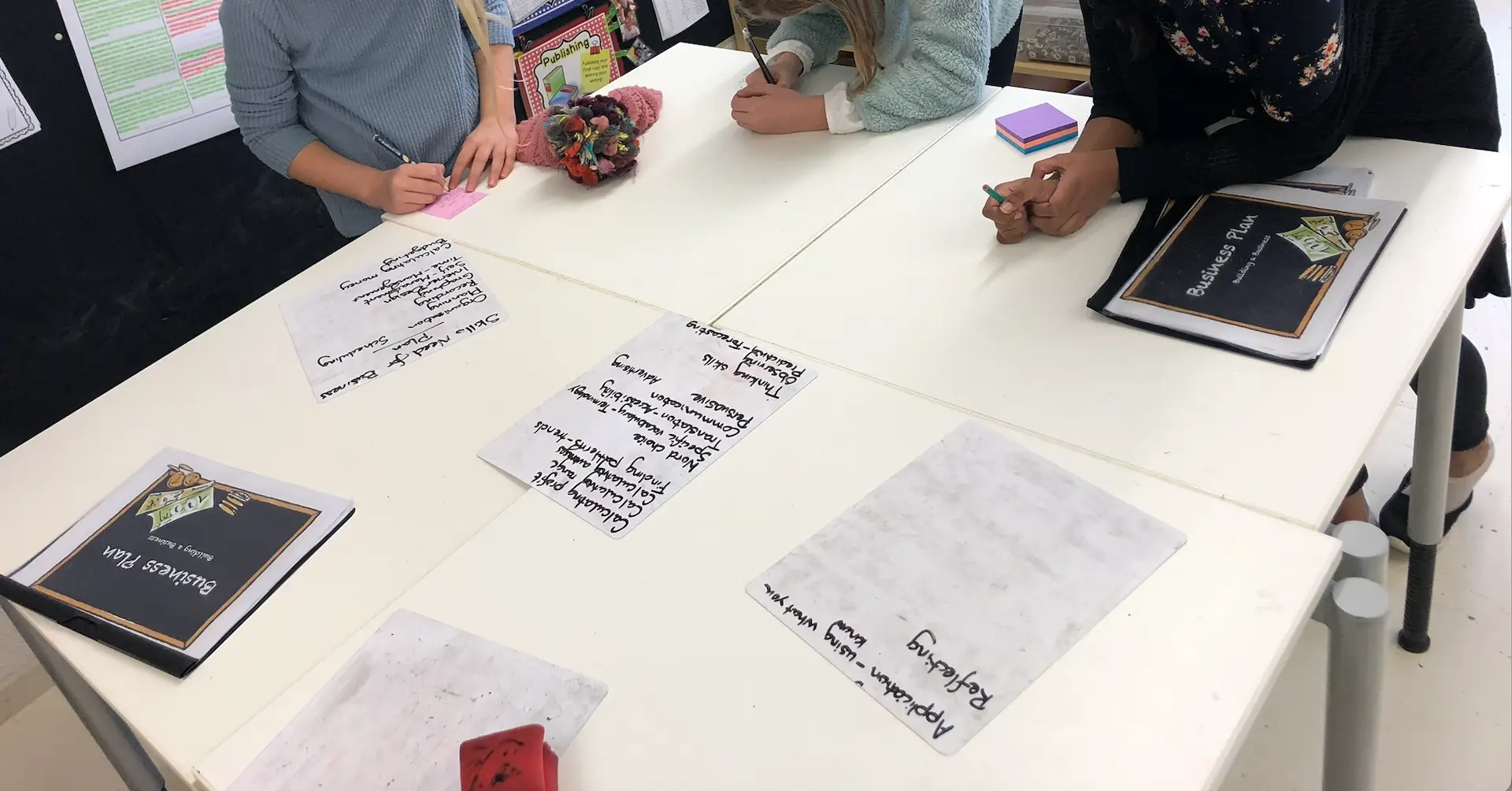

If you want to make this kind of student-led planning process easy and accessible in your own classroom, I’ve turned that business plan into a teacher-friendly resource you can use too. You can find my Ultimate Business Plan Bundle in my Teachers Pay Teachers store.
Giving students a peek at the real structure of a business plan set the tone for everything that came next—they weren’t just going through the motions. They were building something that mattered.
Brainstorming & Business Besties: Teamwork That Works
Okay, let’s be honest—”group work” can either be magical or a total meltdown. But when you’re asking students to launch a small business? Teamwork becomes essential. And if you’ve ever tried to plan a pretend café with a friend who thinks jellybeans belong in soup, you know compatibility matters.
First: The Big Idea
I told my students that they’d be opening their own café. Why a café, you ask?
- Cafés are relatable. Kids know what cafés are. Most have been to one, ordered something, maybe even critiqued a muffin.
- There’s a huge variety of products they can offer—drinks, snacks, treats—but it’s not as complex as opening a full-scale restaurant.
- Most importantly, I wanted them to experience real business competition.
If everyone is running the same type of business, they have to get creative to stand out. I told them, “A great idea is a great start… but what makes your café the one customers will line up for?”
We started with a classroom brainstorming session where students jotted down any café ideas they could think of—fun menus, funky themes, wild ingredients (I may never forget “Cereal Pizza”).
But I didn’t want them just copying whatever idea their bestie whispered during recess. So I sent the real brainstorming home. For homework, each student filled out a card with:
- Their café idea
- A short explanation of what made their business unique
This gave them space to reflect, not just react. Some even surprised me with ideas that felt… dare I say… investment-worthy?
Then: The Partner Search
Once ideas were in, it was time for the next big step: finding a business partner.
We had a class discussion about what makes a good partner. Spoiler alert: “We both like slime” didn’t make the final list. Instead, they came up with gems like:
- Having shared goals and a similar vision for the business
- Bringing different strengths to the table (One’s great at math? The other loves design? Perfect!)
- Being a good communicator, even when things get tough
Students wrote these ideas down so they could reference them later—because let’s be real, it’s easy to forget all that great advice when your best friend starts hinting at a team-up.
Then came the real fun: a Business Speed Dating session. Two minutes with every student in the class to pitch ideas, ask questions, and get a feel for compatibility. There was a real buzz in the room (and zero jellybean soup… phew).
Afterward, students filled out a form naming 1–3 people they’d like to work with, but here’s the kicker:
They had to explain why they wanted to work with them based on ideas or strengths—not just “because we’re neighbors.”
They also had the option to go solo if they preferred.
Once I had all the forms, I played Matchmaker-In-Chief. Most students ended up with someone from their list, but I made a few tweaks to balance out skills and personalities. The result? Strong, thoughtful teams with a shared vision and a real plan to build something awesome.
Bringing in the Big Guns: Learning from a Real Business Consultant
At this point in the unit, my students were bubbling with ideas—and probably more excited about coffee shop names than their actual math homework. But before they jumped headfirst into writing their business plans, I wanted to ground their enthusiasm in real-world insight.
Enter: my then-boyfriend, now-husband, a real-life business consultant for startups.
Yep, I brought in the big guns.

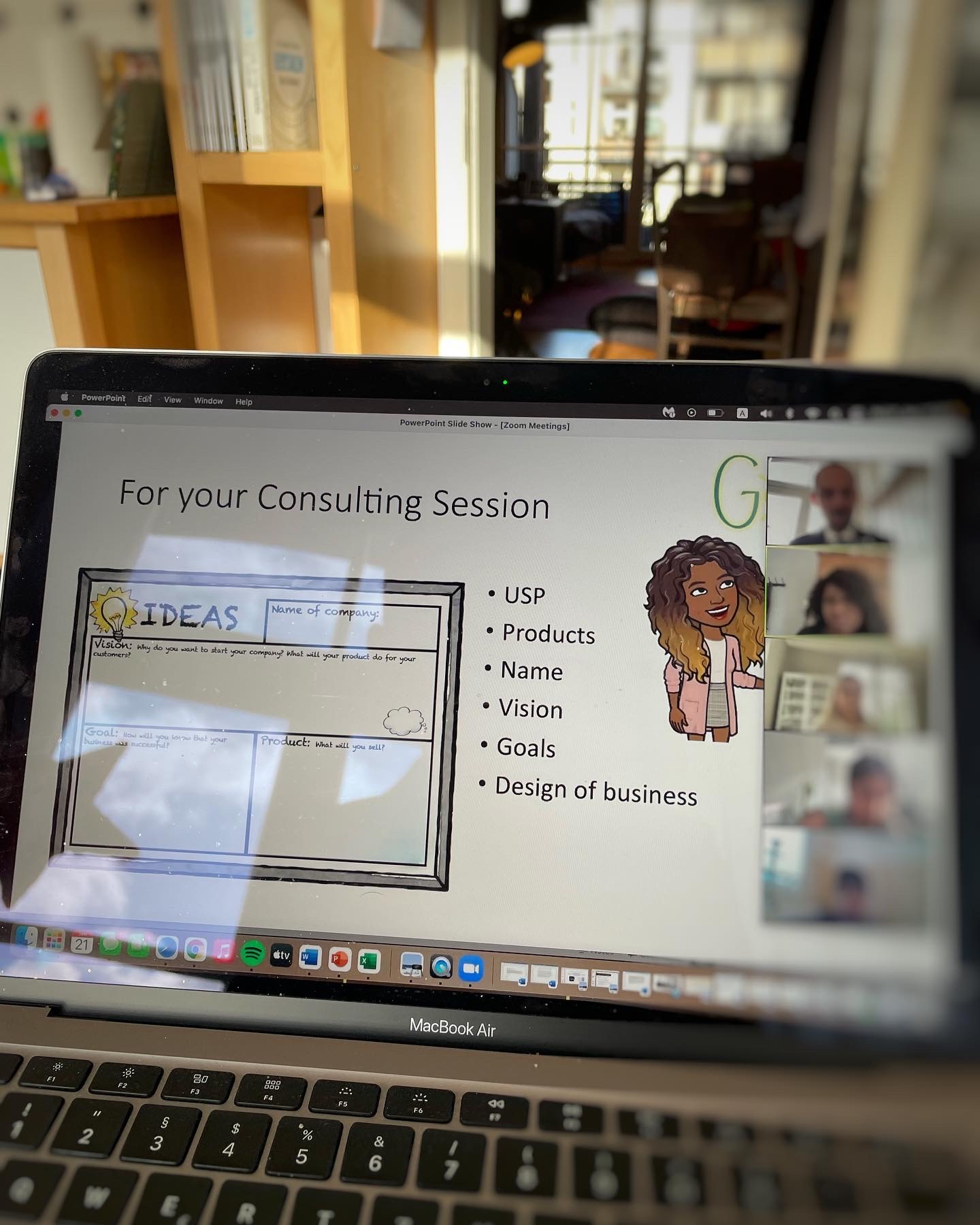
Why Bring in a Business Consultant?
Let’s be honest—kids love hearing from anyone who isn’t their teacher. And hearing directly from someone who helps businesses launch and grow? Instant credibility. It also helped them realize:
- This project was more than just a “school thing.”
- Entrepreneurs use the exact kinds of thinking and planning we were doing.
- Real businesses don’t just wing it. (Even if some of my students hoped they could.)
What the Visit Looked Like
My consultant guest gave a short presentation (virtually or in-person—either works!) explaining:
- What a business consultant actually does
- Why having a plan matters
- How competition, budgeting, and marketing all play major roles in business success
Then came Q&A time. And let me tell you, fifth graders ask excellent questions:
- “What do you do if your first business fails?”
- “How do you convince people to give you money?”
- “Can you be rich and still be nice?”
(We’re still working on that last one.)
Don’t Have a Business Consultant on Speed Dial?
No problem. Here are a few other ways to make this part happen:
- Invite a local business owner to speak to the class (or Zoom in)
- Use pre-recorded interviews or videos of entrepreneurs (Shark Tank snippets work great too)
- Check out kid-friendly articles or podcasts about entrepreneurship
The goal isn’t perfection—it’s giving students a window into the real world and helping them see that what they’re learning matters beyond the classroom.
Bringing in a guest expert added an extra layer of excitement and made the whole unit feel that much more professional. My students felt like they were doing real business work—because they were.
Know Your Rivals: Competitor Analysis Made Kid-Friendly
One of the perks of living in Germany—especially in urban areas—is the abundance of cafes. So when it came time to teach my students about competitor analysis, I didn’t want them just reading case studies or Googling businesses. I wanted them out in the real world, observing how local entrepreneurs operate. That’s why I planned a field trip to a lively neighborhood with three cafes located close together.
Before we went, we talked about the concept of a USP (Unique Selling Proposition)—what makes a business stand out from the rest. We discussed why it matters, especially in a competitive market, and how knowing your rivals can help you better define your own niche.
Each student got a recording sheet with key questions:
-
What makes this cafe successful?
-
What can we learn from them?
-
What is their USP?
-
What would make you stand out among these competitors?
Armed with clipboards and curiosity, the students observed signage, menu choices, decor, pricing, and customer flow. They compared how each business tried to attract and keep customers and took notes on what they could apply to their own ideas—or improve upon.
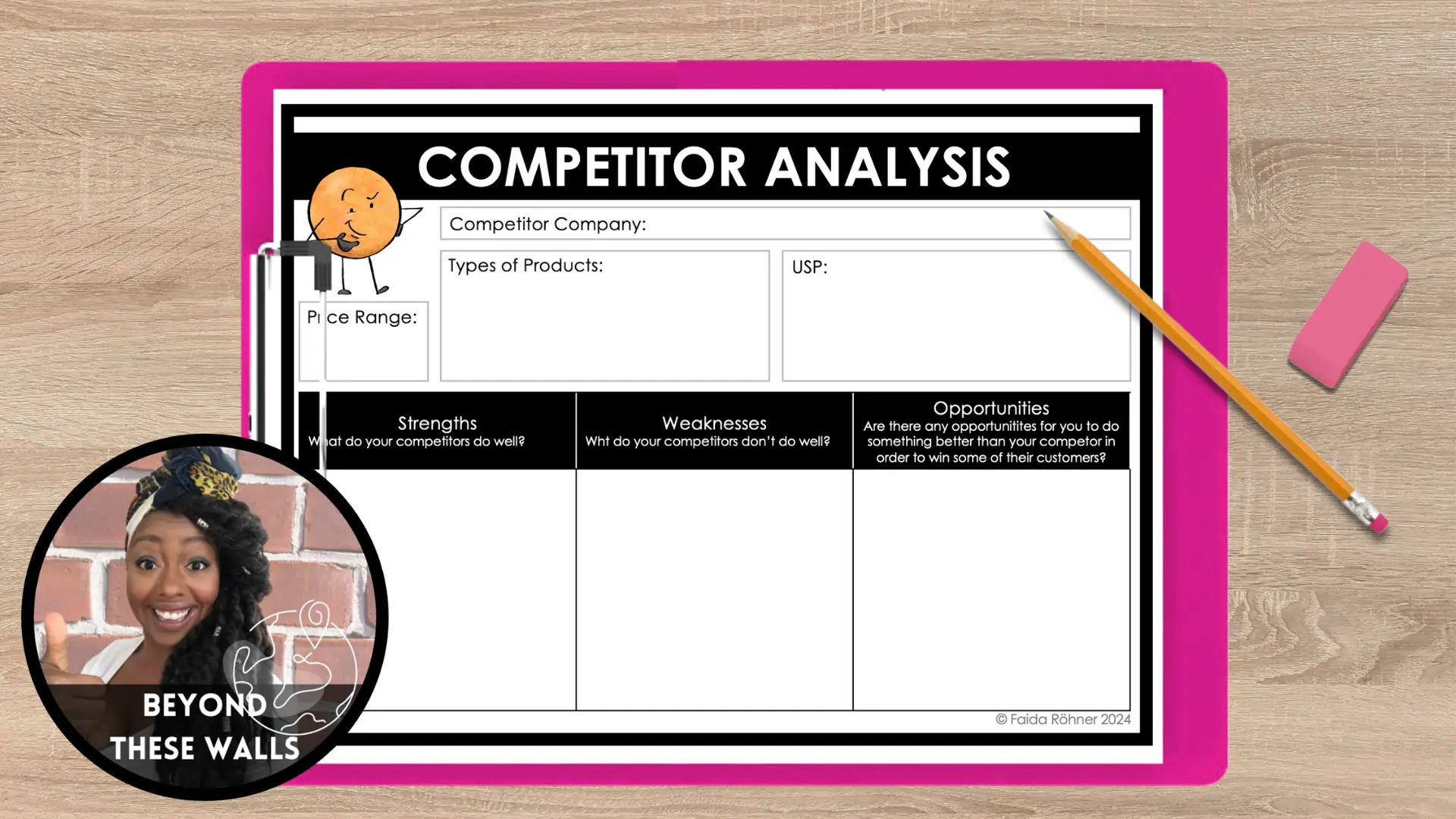
What amazed me most was their level of engagement. They weren’t just filling out a worksheet—they were strategizing. They wanted to outdo these real cafes! They were inspired by the branding of one, the friendly service of another, and the unique products at a third. And then came the creative thinking: “What if we offered something none of them have?” “How could our service be even better?” “Could we combine the best parts of each?”
This activity brought the idea of competition to life in a meaningful, age-appropriate way. It gave students a sense of the real decisions entrepreneurs face and helped them begin shaping their own business identities with intention and insight.

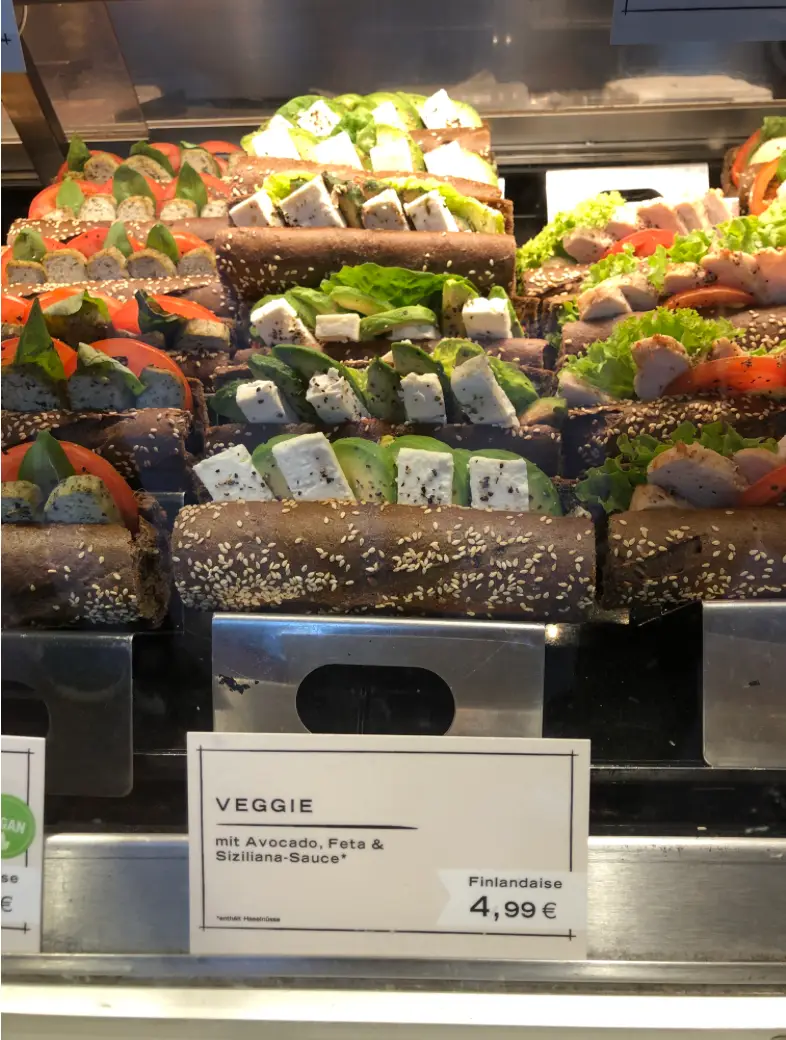
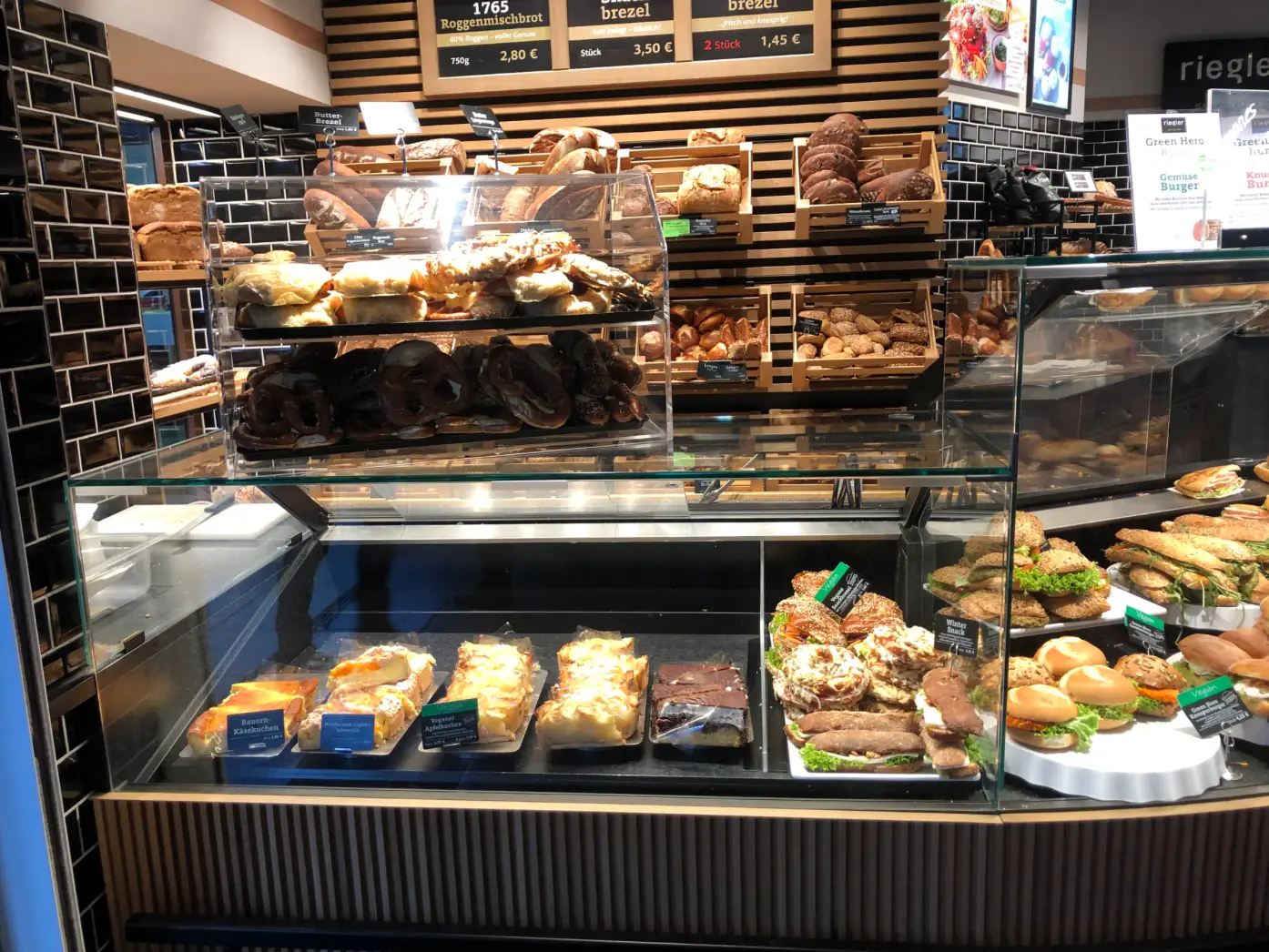
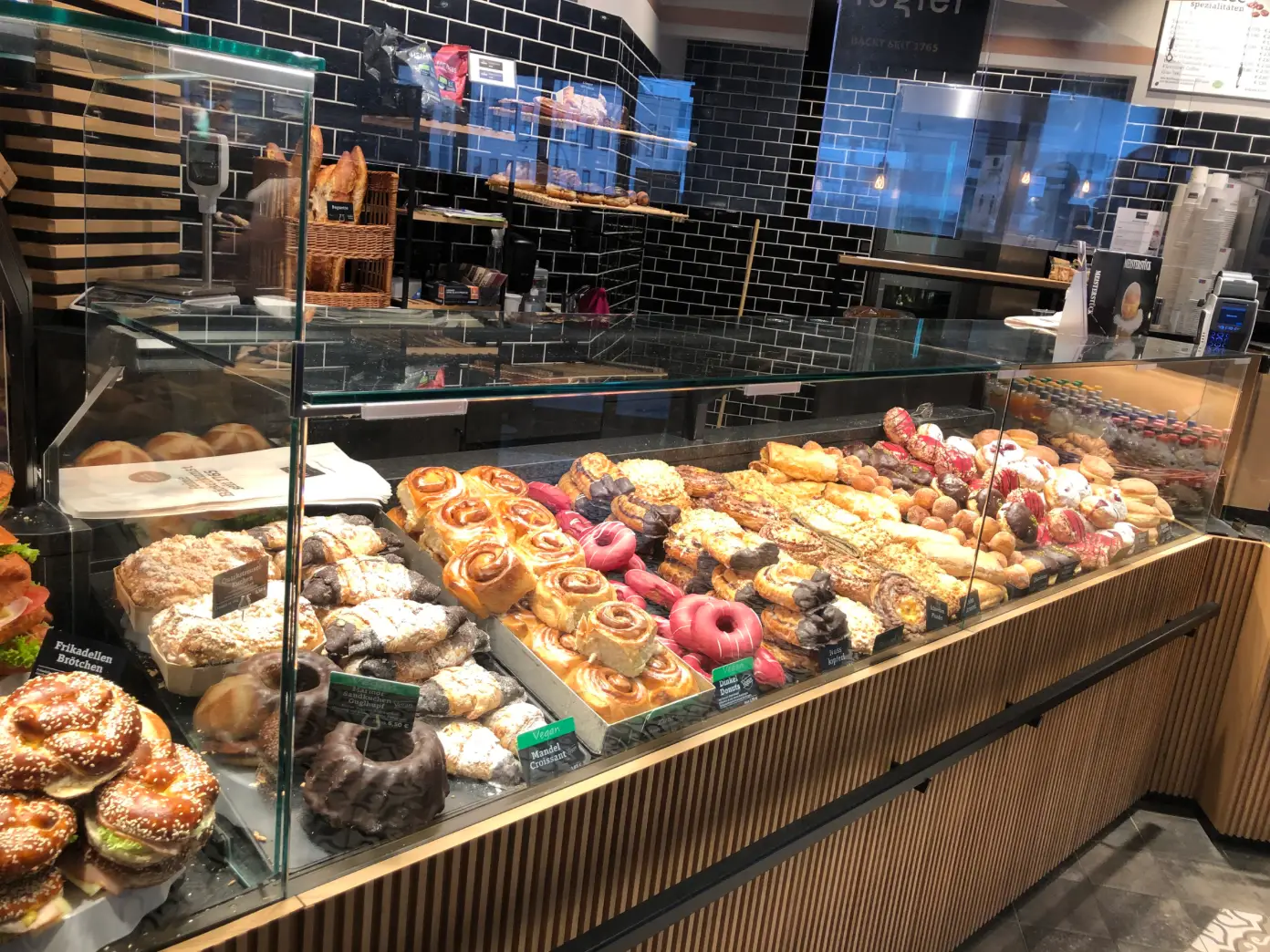
Survey the People: Market Research That Actually Matters
Now that students had scoped out the competition and were refining their ideas, it was time to shift gears and figure out out the million-dollar question: Is this a product people would actually spend money on?
Enter: the survey.
Step 1: Creating a Good Survey (Spoiler: “What’s your favorite color?” Doesn’t Count)
By fifth grade, most students can whip up a basic survey without breaking a sweat. But creating a useful survey—the kind that provides real, actionable insights? That’s next-level stuff.
We started by talking about the importance of asking the right questions. A good survey can help entrepreneurs figure out everything from pricing to packaging to which flavor of muffin will fly off the shelves.
To drive this point home, I pulled out one of my favorite lessons of all time: The Pastry Taste Test. (Because nothing says “real-world learning” like croissants before recess.)
We had just taken a field trip to several local cafes, and I bought pastries from each one for our mystery taste test. I kept things anonymous by labeling each tray with a number, not the name of the cafe. The goal? Figure out which shop offered the best product.

But here’s the twist: I intentionally allowed the class to create a not-so-great survey at first.
Doing a Pastry Test Test
Before starting, we reviewed different types of survey questions:
- Yes/no questions for quick preferences
- Multiple choice for easy data collection
- Checkbox for showing multiple preferences
- Ranking questions to prioritize features or products
- Open-ended questions to get more detailed feedback
Then, as a class, we created a quick survey to help us rate the croissants amongst the three cafes. The questions were… fine. But as we ate and started filling the surveys out, students quickly realized we had forgotten to ask about things like freshness, texture, or whether the options allowed for more than one correct response.
Lightbulb moments all around!
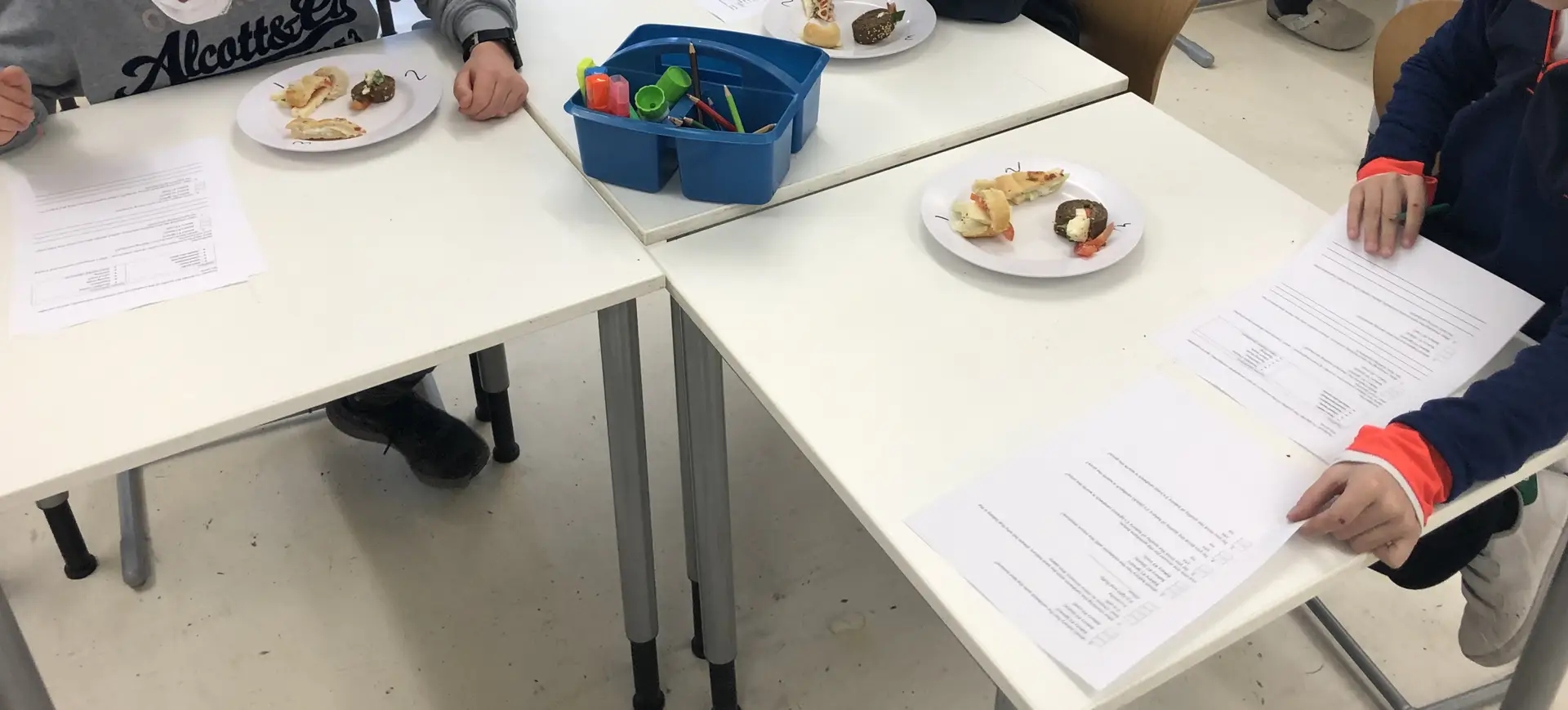
We edited the survey after each round—croissants, then muffins, then other treats—making improvements along the way. By the end, not only were students full and happy (and probably a little sugared-up), but they had created a solid, thoughtful survey they could adapt for their own business.
They were also buzzing with ideas for how they’d use their surveys to fine-tune their offerings.
Step 2: Using the Data (This Part’s Trickier Than It Sounds)
Here’s the truth: even the most amazing survey won’t help if students don’t know how to actually use the data they collect.
Some of my students could jump into analyzing survey results like mini data scientists. Others… stared at the numbers like they were written in an alien language. I knew they needed modeling, practice, and lots of scaffolding.
So before students had to use real survey results for their own business, we practiced:
- As a whole class (so they could see my thought process)
- In small groups (to work collaboratively)
- And individually (so I could see who needed support)
Want a shortcut? I created a resource that gives students additional practice using real survey results to help make business decisions. If you’d like a ready-made way to build these skills in your own classroom, check out my Market Research Survey Analysis Business Graphing Worksheet Questions.
All this practice paid off!
One group, for example, was really excited about launching a spicy-food cafe (think: spicy cinnamon rolls—an acquired taste, apparently). They were convinced it would be their standout item. But after conducting their survey, they realized not a single potential customer wanted anything jalapeno-cinnamon filled pastries . Not one.
At first, they were a bit deflated. But then—total pivot. They discovered another product they hadn’t considered was way more popular and immediately started brainstorming how to turn it into a feature item. I was so impressed by how naturally they used their market research to make a smart, strategic change.
That’s the power of a good survey and knowing how to use the data.
Build the Brand: Logos, Slogans, and the Art of Standing Out
Once the business ideas were locked in and the surveys were done, it was time to answer one of the biggest questions in the world of business: How do you get people to care about what you’re selling?
Enter: branding.
Slogans: Catchy Words with a Purpose
I wanted the slogan-writing process to be more than just a fun word game (though, yes—it was fun). It was also a perfect opportunity to develop language skills and get creative with how we use words to persuade.
We started with a brainstorm. Students made a giant list of all the slogans they knew—everything from fast food jingles to sports brands. I tossed in a few extra favorites of my own to get the ideas flowing.
Then we sorted. What made some slogans better than others? What patterns could we find?
Together, we created a list of “slogan success rules,” which included:
-
- Keep it short and snappy
-
- Use rhyme or rhythm
-
- Try alliteration or wordplay
-
- Leverage the rule of 3
-
- Highlight the USP
-
- Use strong action words
Armed with their rules (and a thesaurus in one hand and a rhyming dictionary in the other), students went to town writing their own slogans. I loved seeing them stretch their vocabulary and play around with language in meaningful, real-world ways.
And yes, I may have heard a few pitches that sounded suspiciously like cereal commercials, but hey—creative genius comes in all forms.
Logos: PowerPoint to the Rescue
Now, when it came to designing logos, I knew I needed to call in some backup. Graphic design isn’t exactly my superpower, so I enlisted our fantastic secondary tech teacher to help.
Since we didn’t have access to any fancy software (and my budget for the year was already spent on croissants), we used PowerPoint. Hear me out—PowerPoint is a fantastic intro tool for graphic design. It lets students focus on layout, color, and composition without the distraction of throwing 38 animations into a slideshow.
How We Got Started:
Each art session began with a short tutorial covering just a few key features:
-
- Home tab: font, color, alignment basics
-
- Insert tab: shapes, images, text boxes
-
- Design tab: background, themes, layout
After the demo, students had time to play around with the tools before starting their actual logo design.
Teaching the Process of Design
The real challenge? Getting students to slow down and engage with the process. You know the ones who finish in five seconds and yell, “I’m doooone!” Yeah. Them.
To shift the mindset from “race to the finish” to “embrace the process,” I set one rule:
Every design decision gets its own slide.
For example:
-
- Can’t decide between green, blue, or gray for the background? Create three slides, one for each.
-
- Want to test out different fonts or layouts? Add a slide for each version.
-
- Try something and scrap it? Keep the slide to show your thinking.
This created a visible trail of their creative choices, which I could then review during conferences.
While They Worked, I…
-
- Sat with students and asked about their design decisions.
-
- Commented on:
-
- How many slides they had (showing their trials and ideas)
-
- Which PowerPoint functions they used
-
- How much they refined their concept
-
- The reasons behind their choices
-
- Commented on:
Why I Loved This Part:
-
- It made the creative process visible and valued.
-
- It gave every student a chance to shine—especially those who don’t see themselves as “artsy.”
-
- The logos looked legit. Like, “I’d-buy-a-coffee-there” legit.
Even better? Students left this activity not just with a logo, but with a deeper appreciation of how creativity, branding, and decision-making are all part of building a business.
Calculating Costs: Budgeting Like a Boss
Once students had brainstormed their cafe concepts, they got to work deciding what delicious products they’d offer. They had total freedom here—croissants, cookies, spicy cinnamon rolls (RIP)—whatever they could dream up (and back up with a recipe). They brought in ideas, chatted with their business partners, and got to work.
But here’s the catch: you can’t just slap a $5 price tag on a muffin because it feels right. We needed to get real about costs.
Step 1: Ingredient Investigation
We focused on ingredient costs—the base cost of actually making their products. I had students:
- Calculate the cost of producing multiple items, not just their top choices.
- Use that info to help decide which products were worth selling and which weren’t so profitable.
Step 2: Research & Real Life Tech Troubles
At first, students researched prices online from local grocery stores. This worked well… until it didn’t. (Shout out to WiFi meltdowns and mystery ingredients that apparently don’t exist on the internet.)
So I made life easier for everyone and created a price sheet with realistic costs for common baking ingredients. Students could focus on the math instead of battling Google, and I could actually check their calculations without doing a deep dive into almond flour inflation.
Step 3: Final Product Decisions
After calculating costs and comparing them to potential selling prices—and thinking about what competitors might charge—students finalized their top 3 products.
They now knew what they wanted to sell, how much it would cost to make, and how much they could realistically earn.
Bosses in the making.
Pitch Perfect: Infographic Business Plan That Sells
By this point in the unit, my students were basically mini moguls. But being a business genius isn’t just about having a great idea—you’ve also got to present it in a way that grabs attention.
So, for their final task, I had students create an infographic-style business plan—a clean, visual, and persuasive pitch to potential investors. Think of it as Shark Tank meets Canva… but with PowerPoint and a lot more glitter.
What the Infographic Included:
- Business name, logo, and slogan
- Clear description of their cafe and its purpose
- A breakdown of products offered
- Graphs and data from their market research
- A persuasive section on why their business will succeed
They got to play around with layout and design, which gave us the perfect excuse to sneak in some extra visual arts learning—hello, space, balance, unity, and contrast.
The infographic could either:
- Stand alone as a polished, one-pager for investors
- Or accompany a short oral pitch where students took the floor as full-fledged entrepreneurs
Want to try this in your own classroom?
Grab my Infographic Template & Rubric (free!)
Or check out the full Business Plan: Opening Your Own Cafe Project. When you purchase the Business Plan, you also get the sample infographic.
Your students will love seeing their hard work come together visually—and you’ll love how much learning they pack into one page.
Pitching to Investors: Student Shark Tank
What’s a business without a little buy-in?
To wrap it all up, students pitched their cafes to real investors—aka my amazing colleagues, who each received an investment check from me. After reviewing the business plans, they had to choose the company they thought would bring them the biggest return.
The pitch could be:
- A verbal presentation, or
- Just their infographic, designed to speak for itself

Students knew ahead of time that their ideas, details, and data had to do the heavy lifting. That knowledge? Total motivation. They were all-in, refining every part of their plan to win over the investors.
And they loved seeing how much money they could raise. Knowing that they were competing with other cafes added a real-world edge—and pushed them to make their business truly stand out.
Bake It Till You Make It: Selling Day Success (Bonus Step)
What’s better than planning a cafe? Running one.
As an awesome extension, we turned our multipurpose room into a mini food market and let students set up their own cafes after school. This was where their business plans went from paper to pastry.
Here’s how it worked:
- Students brought everything from home (with help from grown-ups), tracked what they bought, how much it cost, and handed in their recipes.
- I gave them time in class to prep their business tables, and let me tell you—they took their USP very seriously. We’re talking full-on decor, themed signage, the works.
- They sold their goodies to real customers (parents, teachers, classmates) and finally saw if their planning would actually pay off.
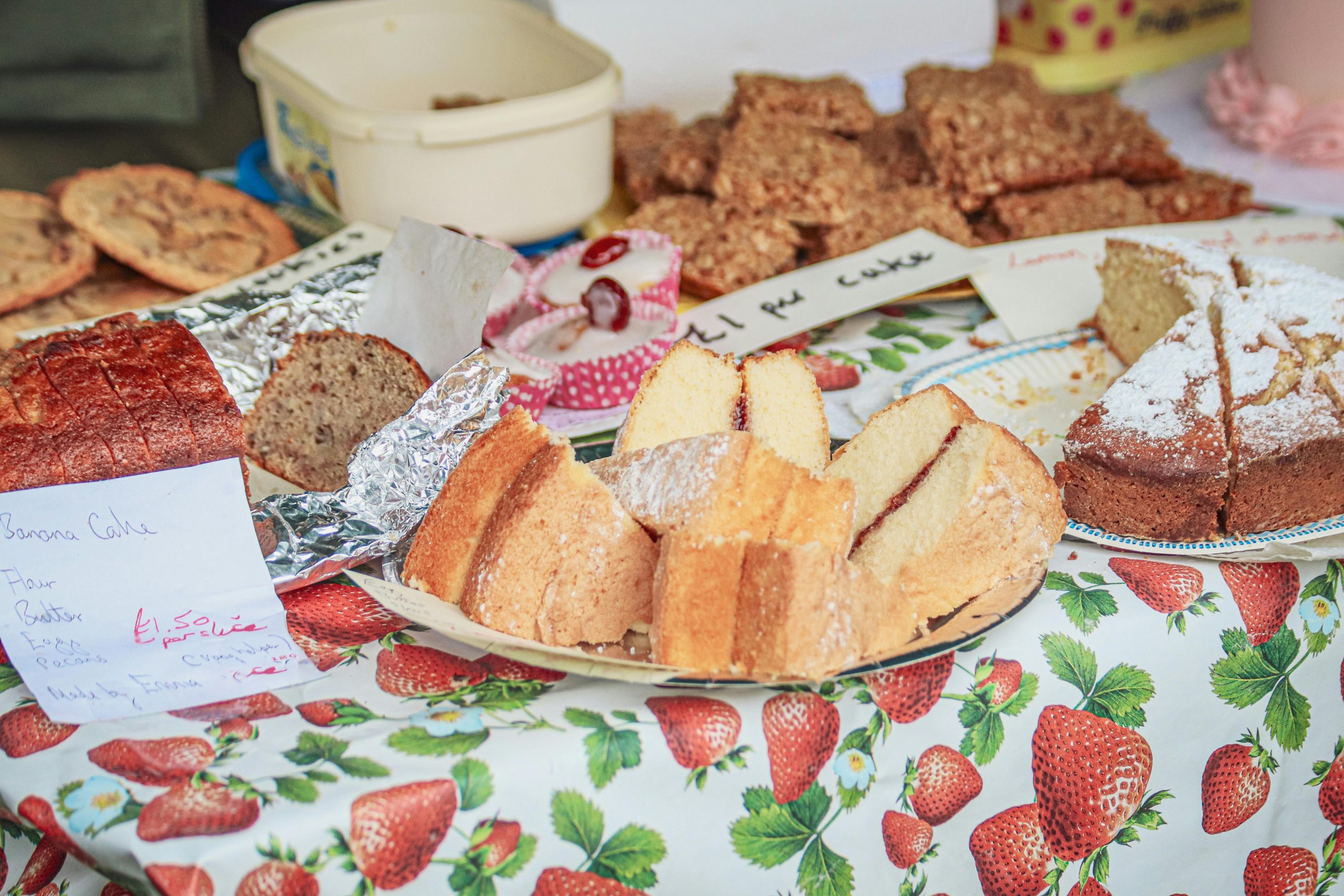
Was it a lot of work? Oh, for sure.
Do I have time to do this step every year. Nope.
Was it worth it, when I could do it? Absolutely.
At the end, students counted their cash, subtracted their expenses—and made real business decisions. My class even decided to donate their profits to a local charity, which gave the whole thing even more heart.
Because in the end, it wasn’t just about the cupcakes. It was about seeing their ideas come to life.
Helping You Teach Business for Kids: From Real Ideas to Real Learning
Through research, collaboration, trial and error, this unit became one of the most transformative learning experiences I’ve ever taught. What started as a simple desire to make economics feel relevant turned into something so much bigger—my students weren’t just completing a project; they were developing entrepreneurial skills they’ll carry with them for years to come.
They practiced:
-
- critical thinking
-
- problem-solving
-
- creativity
-
- data analysis
-
- communication
-
- real-world decision-making.
They pitched ideas, interpreted market research, crafted branding, and even handled profits. Watching them step into the shoes of young entrepreneurs was honestly one of the most rewarding experiences of my teaching career.
I truly hope this post has given you ideas and inspiration for making economics and entrepreneurship come alive in your classroom too. And if you’re ready to dive in but want tools that will actually support your students through the process from start to finish, I highly recommend grabbing my Ultimate Business Plan Bundle on Teachers Pay Teachers. It is perfect for teaching business and entrepreneurial skills to upper elementary and middle school students.
The Ultimate Business Plan Bundle was designed to help teachers run a hands-on, high-impact business unit and includes printable worksheets that support some of the key learning experiences from this article. Inside this bundle, you will find…
-
- A step-by-step student business plan
-
- A market research survey analysis tool that helps students use data to make smart decisions
-
- A Business Plan Frayer Model, with a modified version for your ELLs
-
- A fun, no-prep Business Plan BINGO game to review essential vocabulary
Whether you’re new to teaching entrepreneurship or looking to level up what you already do, this bundle takes the guesswork out and gives you all the structure (and flexibility!) you need.
In teaching entrepreneurship, we can give students the confidence and skills to dream big, think smart, and take on the world—one idea at a time.


